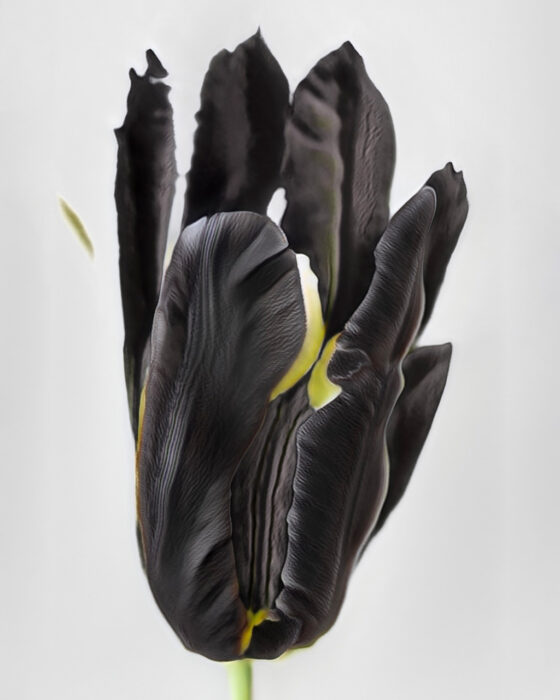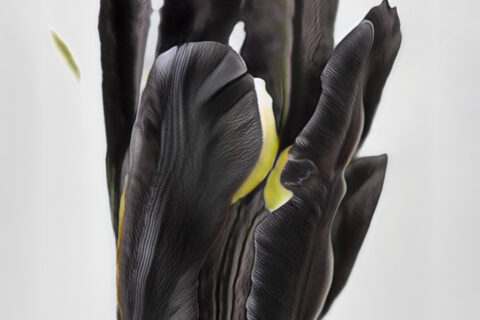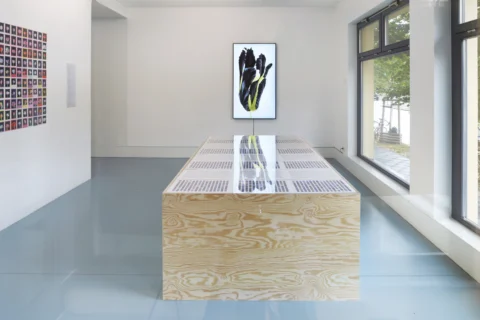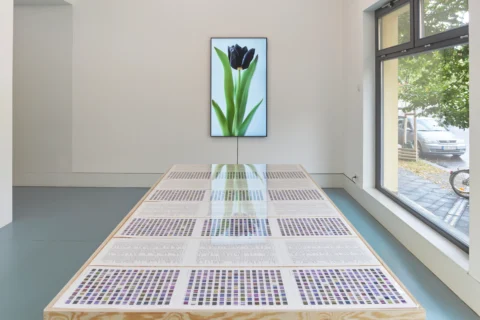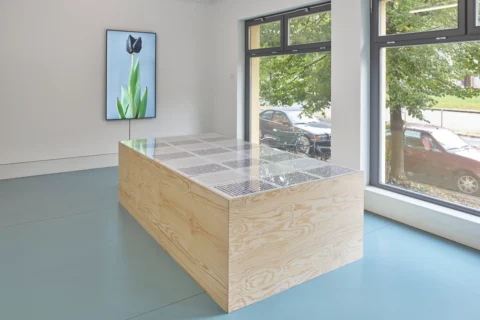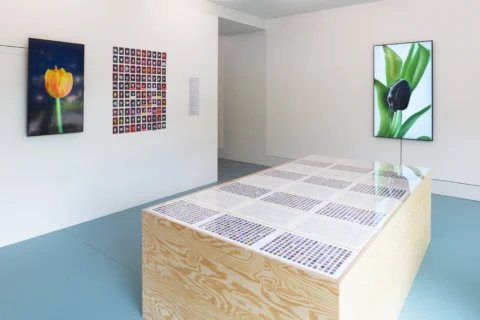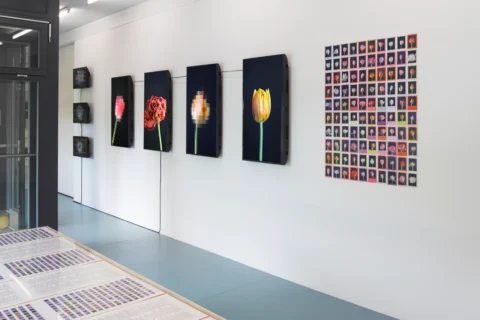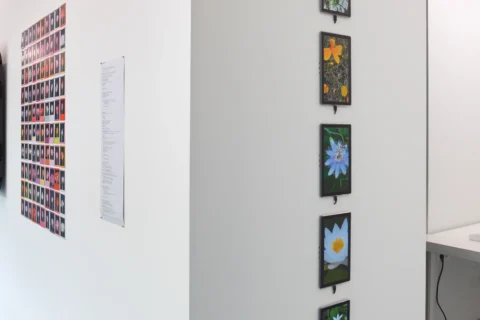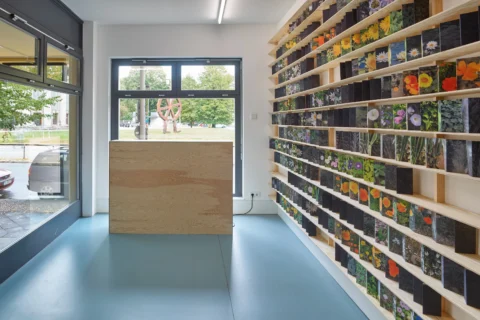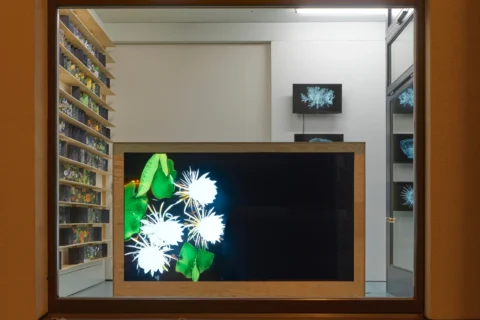Anna Ridler Time Within Time
16/09/2023 – 13/01/2024
Crypto Kiosk
Rosa-Luxemburg-Straße 33
10178 Berlin
Opening / Eröffnung:
Freitag, 15. September 2023, 18 – 21 Uhr
Friday, September 15, 2023, 6 – 9pm
Öffnungszeiten / Opening hours:
Dienstag - Freitag 11 - 18 Uhr, Samstag 12 – 18 Uhr
Tuesday - Friday 11am - 6pm, Saturday 12 – 6pm
The gallery is closed from
December 23, 2023 to January 2, 2024.
Press Release
Anna Ridler, renowned for her unique juxtaposition of the speculative nature of cryptocurrencies and historical economic phenomena, presents her first solo exhibition at Nagel Draxler.
Delving into the intricate interplay between natural rhythms, digital representations, and the dynamics of blockchain time and value, Ridler offers a captivating exploration of these complex concepts. The artist and researcher, born in 1985, is working with systems of knowledge and how technologies are created in order to better understand the world. She is particularly interested in ideas around measurement and quantification and how this relates to the natural world. Her process often involves working with collections of information or data, particularly datasets, to create new and unusual narratives
Ridler holds an MA in Information Experience Design from the Royal College of Art and a BA in English Literature and Language from Oxford University along with fellowships at the Creative Computing¬ Institute at University of the Arts London (UAL). Her work has been exhibited at cultural institutions worldwide including the Victoria and Albert Museum, the Barbican Centre, Centre Pompidou, HeK Basel, the ZKM Karlsruhe, Ars Electronica, Sheffield Documentary Festival and the Leverhulme Centre for Future Intelligence. She was a European Union EMAP fellow and the winner of the 2018-2019 DARE Art Prize. Ridler has received commissions by Salford University, the Photographers Gallery, Opera North, and Impakt Festival. She was listed as one of the nine “pioneering artists” exploring AI’s creative potential by Artnet and received an honorary mention in the 2019 Ars Electronica Golden Nica award for the category AI & Life Art. She was nominated for a “Beazley Designs of the Year” award in 2019 by the Design Museum for her work on datasets and categorisation.
Ridler lives and works in London.
____________________________
A Flowering of Aesthetic Contemplation
Anna Ridler’s work often makes me quiet. Given how much there is to say in any of her projects, such a response seems contrary. But this quietude is the aesthetic that delivers the rest. If unable to still the mind and contemplate— that is, to be with time, in time—much will be missed. The flower is Ridler’s entry into temporal dimensions, technological contrivances, market relations, and social systems. And yet her blooms retain a simple poise, accepting but unencumbered by such heady intellectualizing. One sees, or not, a flower. A tulip, perhaps.
Black Tulip (2023) expands upon the data set Ridler developed for Bloemenveling (2019) but undermines the speculative potential that she had previously cultivated in tying 17th-century Tulipomania to 21st-century high-frequency trading. This new work mitigates hyperinflation or deflation to create a tempered economic engagement, restraining the exponential growth of technology and finance notoriously articulated in Moore’s Law that has contributed to the obsolescence and e-waste that plagues the planet. Making reference to Dumas’ fateful symbol of passion over greed, Ridler reminds us that Earth matter need not serve enterprise and extravagance but support a more personal and planetary graciousness. The minerals and ores, flora, fauna and human labor upturned by business for technological products is not sustainable. Another model is necessary.
The Swedish botanist Carl Linnaeus proposed a floral clock in 1751, a concept that Ridler actualizes. In Circadian Bloom, she offers the chronobiological rhythms of plants, as an alternative to the compression of global digital time. Ridler’s blooms respond to geography, climate, season and sunlight — as do we all. Using complex algorithms tied to a cesium atomic clock, the digital plants respond to their coded latitude and longitude, orchestrating a synchrony between the natural world and our human predilection for temporal control.
Circadian Nocturne (2023) extends this effort with an array of night-blooms, each flowering available through the single board computer of a Raspberry Pi that once activated presents the flower, but only from sunset to sunrise. In a 24/7 attention economy, perpetual access dissipates the sensitivity and value derived from circumstantial engagement. But, we are story-telling creatures, and constraints provide the resistance from which to create a meaningful narrative, to witness and seek what we desire. The loss of sequential time mitigates the possibility of duration, and extension collapses into compressed instants, an atomized modality that proliferates, substituting an accelerationist tempo for the multivariant timescales of our experience. Despite the pervasiveness of our blue light technologies, we are stumbling in the dark. Acknowledging this, Ridler’s Circadian Nocturne shows a different way of being, one that idealizes neither digital nor analog but encourages a more relational approach. The flower flutters. We shift in kind.
These technologies that seem to know so much…what does a computer see in reading an image of a flower? Synthetic Iris Dataset offers a print with the colors in the 150 flowers generated, alongside a list of all the things that a computer vision API interprets from the image. Adapted from the data set that the eugenicist Ronald Fisher established in the 1930s, Ridler corrects its easy acceptance in the majority of beginning machine learning classes. The organization of content is dependent on technological and cultural codes. Her notes reveal these through the humorous duplicity of language. Iris has two meanings in English: the flower and the colored center of the eye. Violet indicates a pigment and the flower. Things are not as simple as they seem.
Through Ridler’s art, audiences are invited to become more discerning of these landscapes and the temporal features each cultivates. Flowers may seem the very opposite of machine learning algorithms, of mechanical clocks, of lasting impressions, though they have an early association with technology and data sets, present distinct temporal rhythms, and appear pressed into memory books. Tempo, temporality, timeframes. Anna Ridler’s aesthetics blossom timescapes with an unerring beauty.
By Charlotte Kent, PhD
